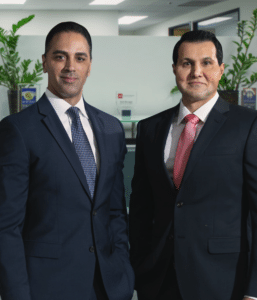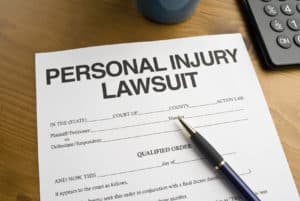What Are the Steps to Filing a Personal Injury Lawsuit in Los Angeles?

Generally, personal injury lawsuits in Los Angeles begin with an insurance claim. The insurance company assigns an adjuster to investigate the claim.
The insurance adjuster determines if the insured is responsible for causing your injury. The insurance company either denies the claim or makes a settlement offer. In many cases, the initial settlement offer is lower than the value of your damages.
Most claims are resolved through settlement negotiations. However, if the insurance company denies the claim or refuses to agree to a fair settlement amount, your option is to file a personal injury lawsuit.
Table of Contents
Steps for Filing a Personal Injury Lawsuit in Los Angeles

Each personal injury case is unique. Therefore, your case could include additional steps.
However, the steps for filing a personal injury lawsuit include the following:
Seek Medical Treatment for Injuries
It is crucial to seek prompt medical care after an accident or personal injury. Delays in medical care could result in allegations of failure to mitigate damages. A delay in medical treatment could also raise questions about whether the accident caused your injuries.
You must be able to prove that the other party caused your injury. Detailed medical records are crucial pieces of evidence in a personal injury case.
Claims Investigation
The insurance company investigates your claim. However, your Los Angeles personal injury attorney conducts an independent investigation.
An attorney may employ one or more experts to assist in the investigation, including an accident reconstructionist, medical specialist, manufacturing expert, and engineer. The type of experts hired for a personal injury lawsuit depends on the type of case and the circumstances involved.
You have the burden of proving the elements of a personal injury claim. Most claims require you to prove the following:
- The other party owed you a legal duty of care
- The party breached the duty of care through their actions or inactions
- The breach of duty was the proximate and direct cause of your injury
- You sustained damages because of the other party’s breach of duty
If you cannot prove the legal elements of your claim, you cannot recover compensation for damages. The investigation uncovers evidence to build a case. Your lawyer also identifies each party responsible for your damages.
Documenting Damages
Your lawyer works with you to document damages. Most personal injury claims include damages for:
- Economic damages, including lost wages, medical bills, and other financial losses
- Non-economic damages, including pain and suffering, permanent impairments, and diminished quality of life
- Future damages include diminished earning capacity, long-term nursing care, and ongoing medical treatment
- Punitive damages, if the defendant’s conduct meets the requirements for these damages
Your lawyer might work with medical experts, economists, and other financial professionals to estimate the value of future damages. The insurance company consistently undervalues damages to lower the amount it must pay for a personal injury claim.
Demand Letter
Your attorney prepares a demand letter. The demand letter explains the legal reasons why the other party is responsible for your damages. It includes the facts of the case, a description of your injuries, and the damages you sustained.
The demand letter offers to settle the claim for a specific amount. Insurance companies might issue a counteroffer, and your lawyer and the company might engage in settlement negotiations. If the negotiations fail, your lawyer prepares to file a lawsuit.
Filing Pleadings
The plaintiff (injured party) files the complaint with the civil court and serves it on the defendant (the party who caused the injury). The complaint provides the facts of the case and the legal causes of action to hold the defendant liable for damages.
The defendant has a specific number of days to respond to the complaint. Typically, the liability insurance company hires a lawyer to represent the defendant. The lawyer might file a counterclaim with the answer alleging the plaintiff is partly at fault for the cause of the accident.
Discovery
The discovery phase of a lawsuit allows each party to gather additional evidence to support their claim. The parties request information from each other through:
- Interrogatories
- Depositions
- Request for Production
- Subpoenas
- Request for Admissions
The parties must respond to the requests under oath. Therefore, the responses can be used against the party if they change anything during their testimony in court.
Discovery allows your lawyer to evaluate the evidence the defense intends to use at trial to fight the claim. It also allows your lawyer to gather additional information and evidence by deposing the defendant and witnesses.
Pre-Trial Motions
The parties may file one or more pre-trial motions. The motions typically deal with matters of law, such as the admissibility of evidence, allegations related to standing, and petitions to dismiss or grant summary judgment.
Settlement Negotiations
The parties may engage in settlement negotiations with or without a mediator. After completing discovery, the parties have a better understanding of the issues involved in the case and the strength and weaknesses of their case and the other party’s case. That understanding could impact a party’s willingness to settle the case instead of going to trial.
Trial
The plaintiff presents their case at the trial first, followed by the defendant. Each party can testify on their behalf and call witnesses to testify. Through testimony, the parties offer evidence for the jury to consider with the testimony.
The plaintiff must prove their case by a preponderance of the evidence. Meeting this burden of proof requires the plaintiff to convince the jury members that the allegations against the defendant are more likely to be true than untrue.
However, if the plaintiff seeks punitive damages, the burden of proof for those damages is by clear and convincing evidence. That burden of proof is slightly higher than by a preponderance of the evidence, but not as high as beyond a reasonable doubt.
After both parties present their case, the jurors deliberate. The jurors are the “triers of fact” in the case. They decide what evidence to believe or disbelieve.
When jurors find in favor of the plaintiff, they also decide how much the defendant should pay for damages. The jurors can also hold the plaintiff partially at fault for the cause of their injuries. If so, they assign a percentage of fault to each party.
California’s contributory fault laws allow a plaintiff to recover damages even though the person is partially to blame for the cause of their injuries. However, the compensation paid to the plaintiff is reduced by their percentage of fault.
Appeal
The plaintiff or the defendant could appeal the jury verdict. However, the party needs to prove legal grounds for appealing the verdict.
Schedule a Free Consultation With Our Los Angeles Personal Injury Lawyer
Our Los Angeles personal injury attorneys at M&Y Personal Injury Lawyers are skilled and aggressive trial lawyers. We fight to get you compensation for your injuries and damages. Contact or call our law firm to schedule a free consultation at 866-864-5477 with one of our experienced Los Angeles personal injury attorneys.
